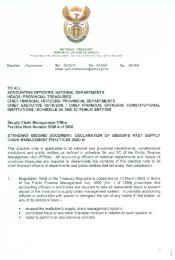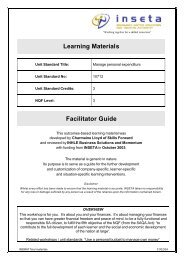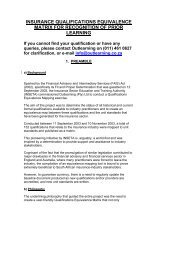SSP Brochure:Layout 1 - INSETA
SSP Brochure:Layout 1 - INSETA
SSP Brochure:Layout 1 - INSETA
You also want an ePaper? Increase the reach of your titles
YUMPU automatically turns print PDFs into web optimized ePapers that Google loves.
Competition from other financial service providers – specifically the banking sector – is also likely to inhibit substantial growth.Employment growth may furthermore be inhibited by technological developments that enable organisations to handle larger volumesof work with fewer employees.Overall, the number of intermediaries (who constitute a substantial component of the sector) is expected to decline as a result of acombination of factors including direct selling by insurance companies, FAIS requirements and new commission structures.c) Replacement demandReplacement demand arises from people retiring, people leaving the sector and mortality. Estimates of retirement were based onthe age distribution of people employed in the insurance sector observed in the Survey of Employment, Scarce and Critical Skills.The age distributions of people in each of the occupational categories were used to calculate the number of people in each categorythat would retire in the next five years. It was assumed that people would retire at the age of 60.In the Survey of Employment, Scarce and Critical Skills employers reported a very low mortality rate for 2004/2005 (approximately0.26% of total employment). In 2002, just more than 1% of the South African population of working age died. Although mortalitywill probably be lower in this sector because of lower HIV infection rates and the fact that the work is not of a dangerous nature,the 0.26% per year reported by employers was considered as too low. 46 Mortality was consequently estimated at 4% over the fiveyearperiod.It was estimated that only 5% of managers would leave the sector in the five-year period. This estimate was based on anecdotalevidence obtained during the <strong>SSP</strong> development process of low attrition rates in this occupational group. It was estimated that thisfigure could be as high as 15% for professionals and for technicians and trade workers. For the rest of staff, it was estimated to be10% over the period resulting in a total of 11 015 people leaving the sector.d) Total demandGiven the negative outlook on employment growth described in Section b) above, two demand scenarios need to be considered.The first scenario is a relative negative one in which there is no employment growth and the positions that need to be filled in thesector originate only from the need to replace employees who leave the sector. In this scenario the insurance sector would have tofill 20 400 positions over a five-year period or approximately 4 000 positions per year. (See column E of Table 2-4)The second scenario allows for a 1.9% growth per year (the level of employment growth observed in the Survey of Employment,Scarce and Critical Skills in the period 2003 to 2005). In this scenario the sector would have to fill just more than 6 000 positionsper year. (See column G of Table 2-4).Table 2.4 Projections of the demand for labour in the insurance sector for the five-year period 2005 to 2010A B C D E F G(B+C+D)(E+F)Current Retirement Mortality Leaving the Total replacement New Total PositionsOccupational groupemploymentsector demand employment to fillManagers 13 520 1 300 540 680 2 510 1 330 3 840Professionals 27 580 1 710 1 100 4 140 6 950 2 720 9 670Technicians and trade workers 1 340 30 50 200 290 130 420Community and personalservice workers 30 0 0 0 0 0 0Clerical and administrative workers 41 580 1 680 1 660 4 160 7 500 4 100 11 600Sales workers 11 400 290 460 1 140 1 880 1 130 3 010Machinery operators and drivers 1 190 40 50 120 210 120 330Other 5 810 340 230 590 1 160 580 1 740Total 102 450 5 390 4 090 11 030 20 500 10 110 30 610Thus, on average, the sector would need to train between 4 000 and 6 000 new employees each year. 47It must be noted that these demand projections are limited to the larger and more formal component of the sector. It does not includeemployment creation that may occur in the micro enterprises and self-employment of individuals. As indicated in Chapter 1 thereis a need for intermediaries who can access emerging markets. Similarly, the exit of brokers who do not comply with the FAISrequirements may also create space for new brokers to come into the market and to set up new businesses. Other business andentrepreneurial opportunities are discussed in Chapter 5.46 Some participants in the <strong>SSP</strong> development workshops also commented that mortality should be higher than 0.026%.47 These employees will not necessarily be new entrants into the labour market. They may also be sourced from other components of the financial services sector or fromelsewhere in the economy.<strong>INSETA</strong> Sector Skills Plan - page 19
















